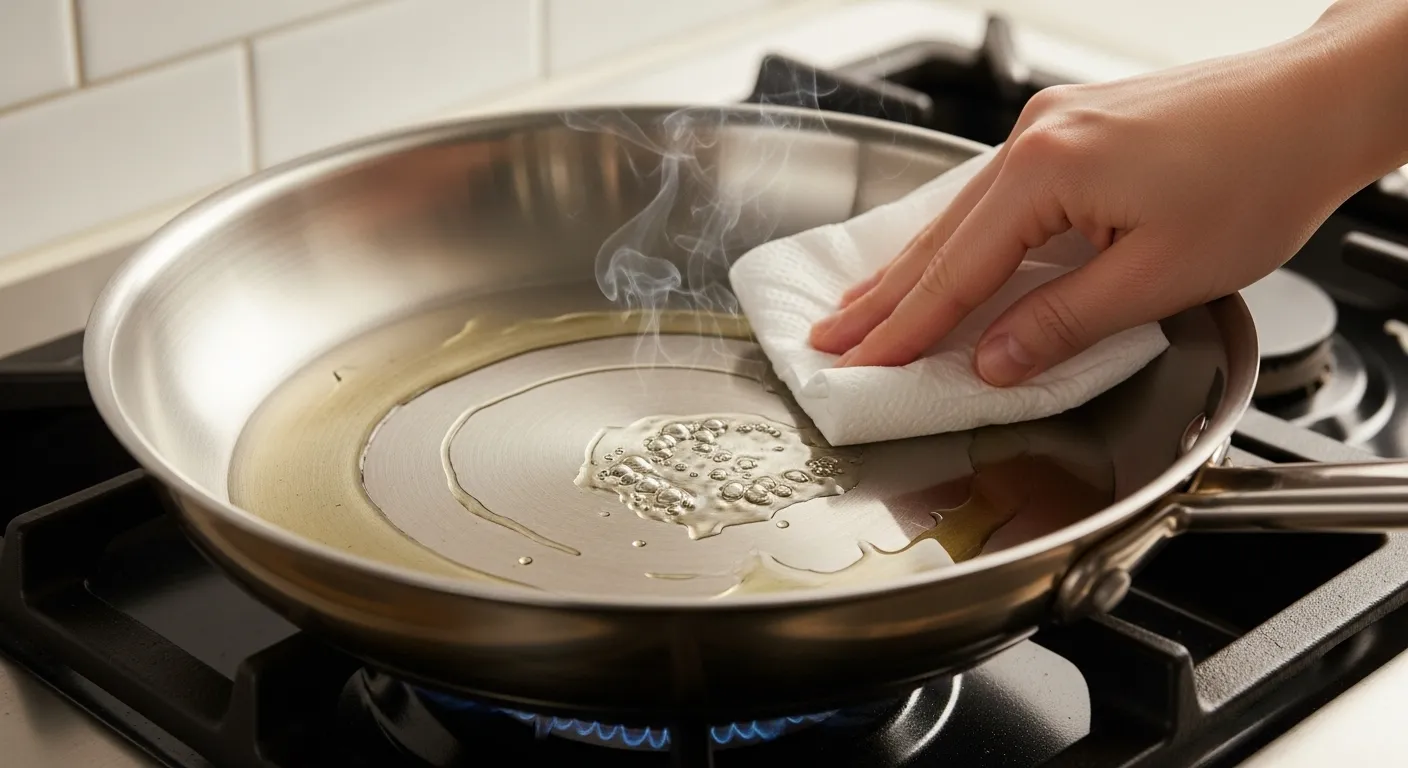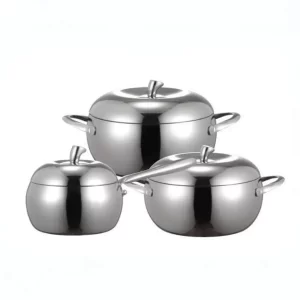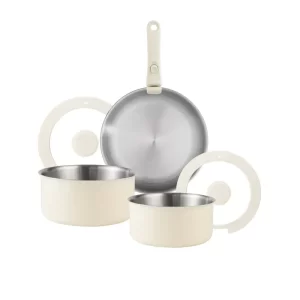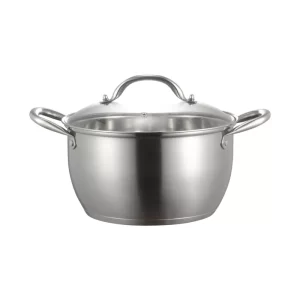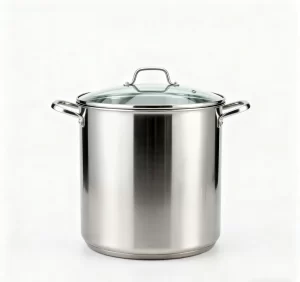Poêles à frire en acier inoxydable Les poêles à frire en acier inoxydable sont très appréciées pour leur durabilité, leur conductivité thermique uniforme, leur santé et leur sécurité, mais de nombreuses personnes sont gênées par leur problème d'adhérence. En fait, grâce à un assaisonnement scientifique et à des techniques d'utilisation correctes, les poêles à frire en acier inoxydable peuvent également obtenir un effet presque antiadhésif. Cet article présente le principe d'assaisonnement, les étapes d'utilisation et les points d'entretien des poêles à frire en acier inoxydable, afin de vous aider à découvrir des méthodes de cuisson plus saines.
À Chancescook, en tant que fabricant professionnel de poêles à frire en acier inoxydableNous proposons des solutions d'ustensiles de cuisine personnalisables et de haute qualité. Que vous recherchiez Services OEM/ODMNous aidons les entreprises à créer des ustensiles de cuisine durables, sûrs et sains.
Table des matières
TogglePourquoi les poêles à frire en acier inoxydable ont-elles besoin d'être assaisonnées ?
La clé de l'amélioration des performances antiadhésives
Bien que la surface de l'acier inoxydable soit lisse, sa microstructure présente des pores. L'assaisonnement peut être réalisé en remplissant ces pores avec de l'huile à haute température, formant ainsi un film protecteur qui réduit le contact direct entre les ingrédients et le corps de la casserole, réduisant ainsi la probabilité de coller à la casserole.
Prolonger la durée de vie des ustensiles de cuisine
La couche d'assaisonnement peut réduire l'oxydation directe du corps de la casserole par les températures élevées, ce qui convient particulièrement aux fritures fréquentes, afin d'éviter la décoloration ou la corrosion de la surface métallique due à une utilisation répétée à haute température.
Revêtements chimiques alternatifs
Le revêtement des poêles antiadhésives traditionnelles peut libérer des substances nocives, tandis que les poêles en acier inoxydable obtiennent des effets antiadhésifs grâce à un assaisonnement physique, ce qui les rend plus adaptées aux familles qui suivent un régime alimentaire sain.
Comment assaisonner une poêle en acier inoxydable ?
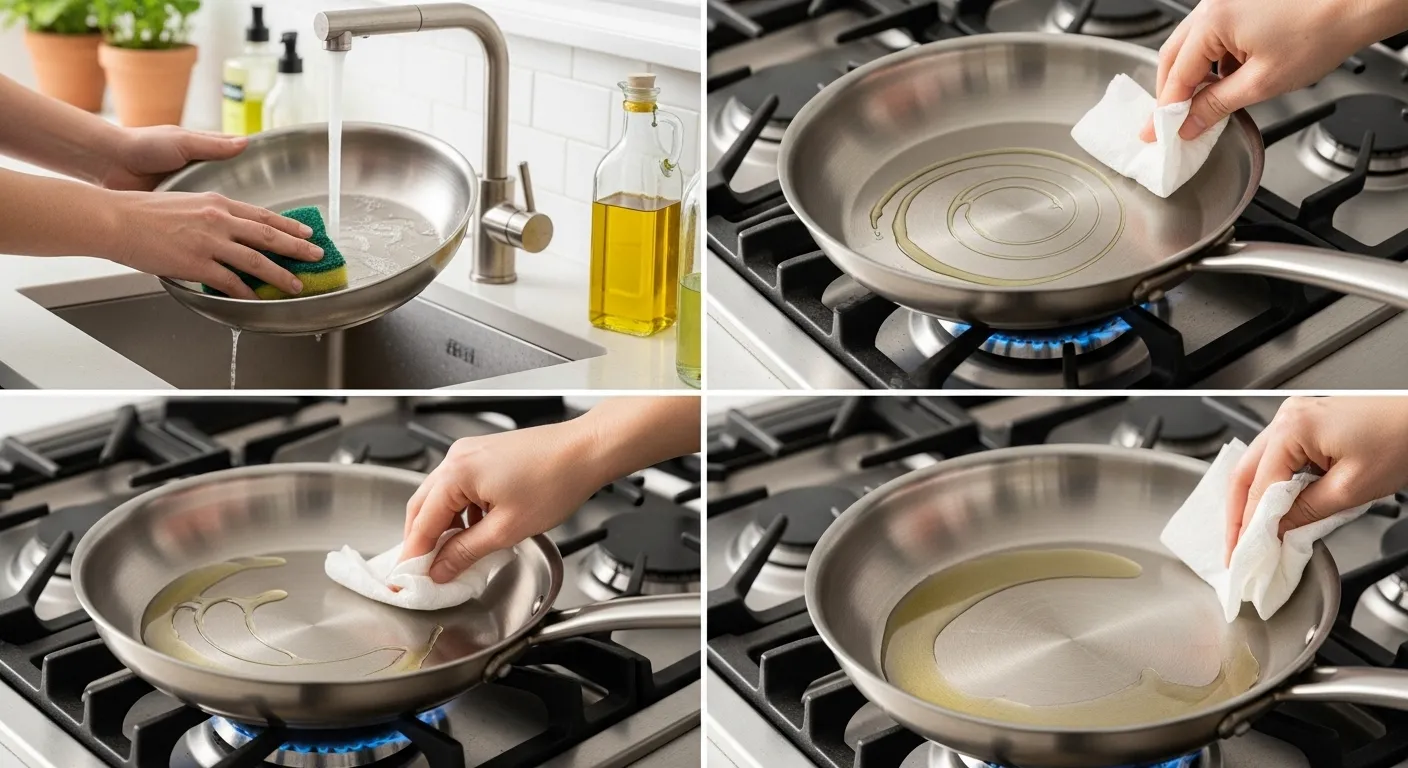
Préparation
Nettoyage du corps du pot
Avant la première utilisation, nettoyez-le soigneusement avec du détergent et de l'eau chaude pour éliminer les résidus d'huile industrielle et permettre à l'huile d'assaisonnement d'adhérer uniformément.
Choisir une huile à point de fumée élevé
Nous recommandons l'huile de pépins de raisin, l'huile d'arachide ou l'huile d'olive raffinée (point de fumée>200 ℃), et évitons les huiles à basse température telles que l'huile d'olive extra vierge.
Processus opérationnel détaillé
Appliquer uniformément l'huile
Verser environ 2 cuillères à soupe d'huile et secouer la casserole pour couvrir les parois intérieures, y compris les bords.
Chauffage à chaleur moyenne
Chauffer à feu moyen ou doux pendant 3 à 5 minutes et observer si le film d'huile est légèrement fumé (ce qui indique que l'huile a commencé à se polymériser).
Refroidissement et essuyage
Après avoir éteint le feu, laissez reposer pendant 30 minutes jusqu'à ce que la casserole refroidisse. Utilisez un mouchoir en papier pour essuyer l'excès d'huile et laisser une fine couche d'huile.
Renforcement répété
Il est recommandé de répéter les étapes d'assaisonnement 2 à 3 fois avant la première utilisation pour renforcer l'effet antiadhésif.
Techniques d'utilisation et d'entretien après le séchage
Points clés de la cuisine
Contrôle du préchauffage
Préchauffer à feu moyen pendant 2 à 4 minutes, puis verser une petite quantité d'eau pour le test. Si les gouttes d'eau roulent au lieu de s'évaporer, cela indique que la température est appropriée.
Transformation des aliments
Veillez à ce que la surface des ingrédients soit sèche, et les aliments surgelés doivent être décongelés à température ambiante pour éviter qu'ils ne collent à la casserole en raison des différences de température.
Gestion des huiles
Lorsque vous faites frire du poisson ou de la viande, vous pouvez d'abord utiliser de l'huile chaude pour humidifier la casserole, puis la vider et ajouter à nouveau de l'huile froide (c'est-à-dire la "méthode de l'huile froide et de l'huile chaude en alternance").
Nettoyage et entretien
Nettoyage en douceur
Après utilisation, nettoyer avec un chiffon doux pendant qu'il est encore chaud. Les taches tenaces peuvent être trempées et bouillies dans de l'eau pour les éliminer. Ne pas utiliser de laine d'acier ni d'eau de Javel.
Resaisonnement régulier
Tous les 1 à 2 mois ou lorsque le pot devient plus collant, répétez les étapes d'assaisonnement pour maintenir la couche protectrice.
Méthode de stockage
Placez un mouchoir en papier ou un tampon en silicone lorsque vous empilez les produits pour éviter de rayer la couche d'assaisonnement.
Idées reçues et réponses scientifiques
Idée reçue 1 : les casseroles en acier inoxydable ne peuvent pas avoir d'effet antiadhésif
Vérité : En assaisonnant et en préchauffant correctement le poisson (par exemple, "poêle froide, huile froide → fumage à haute température → changement d'huile froide"), même le poisson frit peut conserver une peau intacte.
Idée reçue n° 2 : l'assaisonnement peut nuire à la performance du corps de la casserole
Vérité : l'assaisonnement ne fait que modifier l'état physique de la surface, n'implique pas de réactions chimiques et peut réduire l'érosion de l'acier inoxydable par des ingrédients acides.
Idée reçue n° 3 : il faut se fier aux revêtements antiadhésifs des poêles à frire
Vérité : Les casseroles en acier inoxydable sont plus durables et permettent de concilier santé et commodité grâce à des techniques telles que la cuisson à feu doux ou moyen ou l'utilisation d'une huile à haute teneur en fumée.
Scénarios applicables et recommandations de recettes
Meilleur type de cuisson
Friture et grillade à haute température : steak, saumon (le contrôle de la chaleur permet d'obtenir un extérieur croustillant et un intérieur tendre).
Plats à faible teneur en huile : crêpes aux légumes, crêpes aux racines de lotus (en utilisant la capacité de stockage de la chaleur de la casserole pour réduire la consommation d'huile).
Exemple de recette classique : Saumon poêlé
Sécher le saumon et le saler des deux côtés.
Préchauffer la marmite à feu moyen jusqu'à ce que des gouttes d'eau roulent, puis verser l'huile à haute teneur en fumée.
Faire d'abord frire la peau du poisson dans la poêle, appuyer doucement pendant 15 secondes pour qu'elle prenne, retourner et mettre à feu doux pour terminer la cuisson.
Pourquoi choisir Chancescook ?
Chancescook est une usine directe et un fabricant expérimenté spécialisé dans les ustensiles de cuisine en acier inoxydable. Voici pourquoi des partenaires internationaux nous font confiance :

- Prix direct d'usine: Pas d'intermédiaires, des solutions rentables pour vous aider à rester compétitif.
- Personnalisation OEM/ODM: Impression du logo, emballage, conception de la poignée, finition de la surface - le tout adapté à votre marque.
- Contrôle strict de la qualité: Des lignes de production avancées et un système de contrôle qualité complet garantissent que chaque moule répond aux normes d'exportation.
- Soutien flexible aux commandes: Prise en charge des commandes en gros et des petites commandes d'essai, avec un délai de production rapide.
- Expérience de l'exportation outre-mer: Des années d'expérience dans le commerce extérieur, avec des ustensiles de cuisine exportés vers l'Europe, l'Amérique du Nord, l'Asie du Sud-Est, etc.
Nous ne sommes pas seulement votre fournisseur - nous sommes votre partenaire de fabrication à long terme pour réussir sur le marché des ustensiles de cuisine.
Conclusion
L'assaisonnement des poêles à frire en acier inoxydable n'est pas seulement une technique, mais aussi la manifestation d'un mode de vie sain. Grâce à un entretien scientifique, il permet non seulement de rivaliser avec la commodité des poêles antiadhésives, mais aussi d'éviter les risques de sécurité liés aux revêtements chimiques. Après avoir maîtrisé ces techniques, vous découvrirez que le potentiel des casseroles en acier inoxydable dépasse largement les attentes - du sauté maison à la cuisine occidentale exquise, vous pouvez tout faire avec facilité. Essayez-le dès maintenant et rafraîchissez votre expérience de la cuisine !
Chancescook est là pour soutenir votre marque ou votre entreprise avec des poêles à frire en acier inoxydable de qualité qui allient sécurité, performance et style. Laissez-nous vous aider à fournir de meilleurs ustensiles de cuisine à vos clients !

